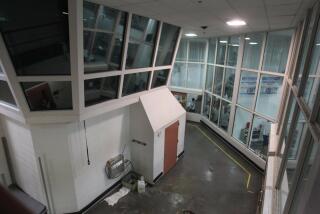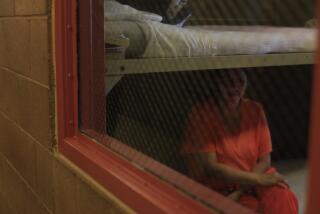Deadly medical lapses in prison
SAN FRANCISCO — As many as one in six deaths of California prison inmates last year might have been preventable, according to a study of medical care in 32 state lockups that will be used to help rebuild the troubled system.
One inmate, who reported extreme chest pains in the middle of the night, died of a heart ailment after waiting eight hours to see a doctor.
Another who complained for days of severe abdominal pain died of acute pancreatitis after medical staff did not believe his pleas were credible.
A third died after a two-year delay in diagnosis of his testicular cancer.
And an asthma patient died after failing to receive steroid medication for two days following transfer from a county jail.
The report, released Wednesday by the court-appointed receiver in charge of healthcare for the state’s 173,000 prisoners, revealed a broad pattern of delays in diagnosis, poor inmate access to doctors and tests, botched handling of medical records, and failure of medical staff to recognize and treat dangerous conditions.
Officials said some lapses led to disciplinary actions against doctors and nurses.
There were 426 deaths in 2006, including 43 suicides, and the study examined 381 of them.
Eighteen deaths were found to be preventable, meaning better medical management or a better system of care would have prevented deaths. An additional 48 were found to be “possibly preventable,” meaning better medical management of a system of care might have prevented death.
Of the deaths considered preventable, six were from asthma, which receiver Robert Sillen said he intended to make a priority for reforms.
“The leading cause of [preventable] death being asthma is unconscionable, and it is evidence of systemic problems and problems with individual clinical judgments,” Sillen said in an interview. “Adults in 21st century California should not have asthma as a primary cause of death.”
Sillen said the report, which concluded that problems such as human error, staffing shortages and poor medical records contributed to unnecessary deaths, provided additional evidence that the state’s $1.5-billion-a-year medical care system needed to be rebuilt from the bottom up.
As part of a 2001 class-action suit that alleged substandard care of inmates, U.S. District Judge Thelton Henderson seized control of prison healthcare.
In 2006, he named Sillen, a former health official from Santa Clara County, to run the medical system and gave him a mandate to elevate treatment to constitutional standards.
The Bay Area-based Prison Law Office, which filed the suit on behalf of inmates, has been critical of the speed of Sillen’s efforts to fix the system. But Steve Fama, one of the attorneys who filed the suit, commended the death report’s timeliness and thoroughness.
“It is very important that was done not only to provide a baseline but also to identify factors that can be addressed to reduce the number of preventable deaths and the other lapses in care,” he said. “Unfortunately at some prisons, the number of physicians available is nowhere near sufficient to meet the need for doctors’ appointments.”
Dr. Stuart Bussey, president of the Union of American Physicians and Dentists, which represents prison doctors, said: “We feel that the doctors in [the prisons] have been working in a battlefield situation. They do not have the tools to practice good medicine. The system needs work.”
Seth Unger, press secretary of the California Department of Corrections and Rehabilitation, which operates the prisons, declined to comment on the report, saying that Sillen was now in charge of healthcare.
Although the receiver’s office said it knew of no similar studies in other states, court-ordered studies before Sillen’s appointment found significant proportions of preventable inmate deaths in California.
Sillen said his study provided a comprehensive and detailed analysis that would serve as a benchmark as he worked to reform the system.
The study by Dr. Kent Imai, who worked with Sillen at the Santa Clara Valley Medical Center, analyzed individual death reviews performed by the state’s corrections agency.
The report, which did not name the institutions or the inmates for privacy reasons, concluded that some sudden deaths involved failures by doctors and other staff to adequately evaluate “red flag” symptoms such as chest pain, dizziness and passing out in patients with heart attack risk factors.
In an episode that the receiver’s office said illustrated a difference between emergency medical access in prisons and in the outside world, an inmate with low blood pressure and an irregular heartbeat put in a written “sick call” request during the night but a nurse did not see the slip until eight hours later. Although a doctor then responded quickly and sent the inmate to a hospital, he died.
The study said one prisoner died from a perforated duodenal ulcer after doctors and nurses failed to adequately respond to the inmate’s repeated complaint about severe stomach pain over five days.
But another patient who had recurring stomach pain, vomiting and a history of hernias died of a hernia condition after a five-week delay in a referral to a specialist -- one of the long-standing problems in the system.
One inmate complained of severe stomach pains nine times over three days, but the review found that medical staff did not believe him. He died of acute pancreatitis.
Rachel Kagan, a spokeswoman for the receiver, said that in the prison medical culture, the staff sometimes suspects inmates of faking illnesses. “We hear that a lot,” she said. “But there should be clinical expertise to make that decision, rather than a bias.”
The receiver’s office identified one preventable death involving a 30-year-old inmate who had chronic pain in his testicles -- and officials said it highlighted multiple breakdowns that resulted in a two-year delay in his cancer diagnosis.
At one prison, a doctor ordered a magnetic resonance imaging test because antibiotics offered the inmate no relief, but the inmate was transferred to another prison before the MRI was performed.
At the second prison, another doctor prescribed antibiotics, which did not work, and ordered an MRI, which was performed. When the inmate was transferred to a third prison, some of his medical records did not follow him -- and by the time he was hospitalized, the cancer had spread through his body and he died.
Fixing the entire medical system, Sillen said, could take a decade or longer and cost huge sums of money.
But will the number of preventable deaths go down next year?
“I don’t know,” he said. “It might be foolishly optimistic to think we are going to have that kind of impact in our first 24 months.”
--
--
(BEGIN TEXT OF INFOBOX)
California prison deaths
The court-appointed receiver placed in charge of state prison healthcare found that many deaths in 2006 could have been prevented with proper care. Of 381 prison deaths studied by the receiver’s office, 18 were determined to have been preventable and 48 others were judged to possibly have been preventable.
Top 3 causes of preventable deaths
Asthma: 6
Sudden cardiac arrest: 3
Congestive heart failure: 2
Top 3 causes of possibly preventable deaths
Sudden cardiac arrest: 5
Valley fever: 4
AIDS: 4
Top 3 causes of non-preventable deaths
Cancer: 105
End-stage liver disease: 53
Sudden cardiac arrest: 28
Source: California Prison Health Care Receivership Corp.
More to Read
Sign up for Essential California
The most important California stories and recommendations in your inbox every morning.
You may occasionally receive promotional content from the Los Angeles Times.










